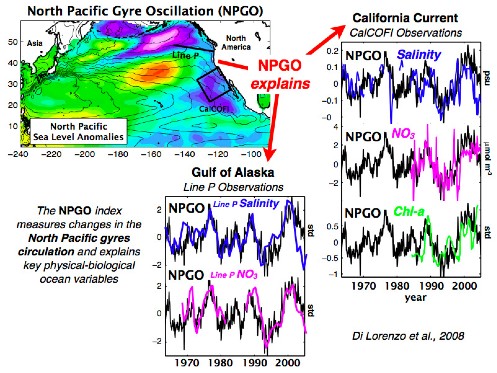Key words :
climate change,
climate change
,marine life
,united states
,fisheries
,north pacific gyre oscillation
,biodiversity
,ecosystem
The North Pacific Gyre Oscillation Links Ocean Climate and Ecosystem Change
19 May, 2008 11:31 am
During the last several decades, dramatic fluctuations in marine ecology have been observed off the western coast of the United States. These fluctuations can be detrimental to marine life, as in the mid 1970?s when a sharp decline in zooplankton occurred off the coast of California. Zooplankton are food for larger marine animals and their absence may have been responsible for an overall decrease in the populations of different coastal marine species during this time. Scientists have been investigating the connection between marine ecosystems and the natural cycles of the ocean circulation but these links remain unclear. For the first time, a new climate pattern called the North Pacific Gyre Oscillation (NPGO) may help elucidate these links by explaining the changes in the ocean water that have an impact on marine ecosystems.

In 1945, following a dramatic collapse of sardine catches in the California Current, the California Cooperative Ocean Fisheries Investigations (CalCOFI) began an extensive sampling program to measure ocean circulation, temperature, salt and nutrient content, plankton and fish larvae along the west coast of the United States. Similar programs were initiated in the Gulf of Alaska by the Canadian fisheries and led to another collection of physical and biological data known as Line-P. Today the CalCOFI and Line-P data together provide an unprecedented view of the ecosystem and ocean climate of the Northeast Pacific from the 1940ís to the present.
Using this data, scientists at the Georgia Institute of Technology show, in a recent study published in Geophysical Research Letters, that since about 1950, changes in physical and biological variables important for marine ecosystems are nearly identical to changes in the strength of the NPGO climate pattern. The NPGO was identified by Professor Emanuele Di Lorenzo and colleagues using satellite data and is described by a pattern of ocean currents which strengthen and weaken on decadal and multi-decadal timescales. The fact that changes in the NPGO coincide with changes in the ecosystem are consistent with other studies that show decadal variations in various other regional marine ecosystems.
In a companion study, the variations of the currents described by the NPGO as it oscillates in strength was investigated to try and understand why changes in the intensity of the NPGO coincide with these changes in key physical and biological variables. Using a state of the art ocean model to mimic the cycle of the NPGO, it was found that the strength of the currents associated with this climate pattern influence the strength of coastal upwelling, a key process that affects marine productivity. Strong coastal upwelling causes warmer surface waters to move offshore and be replaced by cooler, nutrient rich waters from below which encourage marine productivity.
Likewise, less nutrient rich waters are brought to the surface when coastal upwelling is weak, inhibiting marine growth. Therefore, as the intensity of the NPGO oscillates, so do these extremes of coastal upwelling resulting in similar oscillations in the CalCOFI data and ecosystems. Satellite data reveal that the NPGO may intensify with global warming and as such, the authors believe that the NPGO is the key to understanding how the marine ecosystem of the Northeast Pacific ocean will change if the world continues to warm.
References:
Webpage: http://www.ocean3d.org/npgo
Di Lorenzo E., Schneider N., Cobb K. M., Chhak, K, Franks P. J. S., Miller A. J., McWilliams J. C., Bograd S. J., Arango H., Curchister E., Powell T. M. and P. Rivere, 2008: North Pacific Gyre Oscillation links ocean climate and ecosystem change. Geophys. Res. Lett., 35, L08607, doi:10.1029/2007GL032838.
Chhak, K. and E. Di Lorenzo, 2007: Decadal variations in the California Current upwelling cells. Geophys. Res. Lett., 34, L14604, doi:10.1029/2007GL030203.







Further reference: ?Reliability of sea-surface temperature data taken during war time in the Pacific?, PACON Conference Paper: August 8-9,1997 ?The Chinese University of Hong Kong?; in: Pacon 97 Proceedings October 97 pp. 240-250; http://www.oceanclimate.de/English/Pacific_SST_1997.pdf